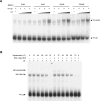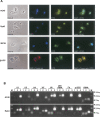Spliceosomal snRNAs in the unicellular eukaryote Trichomonas vaginalis are structurally conserved but lack a 5'-cap structure
- PMID: 18596255
- PMCID: PMC2491460
- DOI: 10.1261/rna.1045408
Spliceosomal snRNAs in the unicellular eukaryote Trichomonas vaginalis are structurally conserved but lack a 5'-cap structure
Abstract
Few genes in the divergent eukaryote Trichomonas vaginalis have introns, despite the unusually large gene repertoire of this human-infective parasite. These introns are characterized by extended conserved regulatory motifs at the 5' and 3' boundaries, a feature shared with another divergent eukaryote, Giardia lamblia, but not with metazoan introns. This unusual characteristic of T. vaginalis introns led us to examine spliceosomal small nuclear RNAs (snRNAs) predicted to mediate splicing reactions via interaction with intron motifs. Here we identify T. vaginalis U1, U2, U4, U5, and U6 snRNAs, present predictions of their secondary structures, and provide evidence for interaction between the U2/U6 snRNA complex and a T. vaginalis intron. Structural models predict that T. vaginalis snRNAs contain conserved sequences and motifs similar to those found in other examined eukaryotes. These data indicate that mechanisms of intron recognition as well as coordination of the two catalytic steps of splicing have been conserved throughout eukaryotic evolution. Unexpectedly, we found that T. vaginalis spliceosomal snRNAs lack the 5' trimethylguanosine cap typical of snRNAs and appear to possess unmodified 5' ends. Despite the lack of a cap structure, U1, U2, U4, and U5 genes are transcribed by RNA polymerase II, whereas the U6 gene is transcribed by RNA polymerase III.
Figures






Similar articles
-
Unconventional features in the transcription and processing of spliceosomal small nuclear RNAs in the protozoan parasite Trichomonas vaginalis.Int J Parasitol. 2024 May;54(6):257-266. doi: 10.1016/j.ijpara.2024.03.001. Epub 2024 Mar 5. Int J Parasitol. 2024. PMID: 38452964
-
Identification of the major spliceosomal RNAs in Dictyostelium discoideum reveals developmentally regulated U2 variants and polyadenylated snRNAs.Eukaryot Cell. 2006 Jun;5(6):924-34. doi: 10.1128/EC.00065-06. Eukaryot Cell. 2006. PMID: 16757740 Free PMC article.
-
Patterns of conservation of spliceosomal intron structures and spliceosome divergence in representatives of the diplomonad and parabasalid lineages.BMC Evol Biol. 2019 Aug 2;19(1):162. doi: 10.1186/s12862-019-1488-y. BMC Evol Biol. 2019. PMID: 31375061 Free PMC article.
-
Structural features of U6 snRNA and dynamic interactions with other spliceosomal components leading to pre-mRNA splicing.Biochimie. 1996;78(6):436-42. doi: 10.1016/0300-9084(96)84750-x. Biochimie. 1996. PMID: 8915533 Review.
-
Role of the snRNAs in spliceosomal active site.RNA Biol. 2010 May-Jun;7(3):345-53. doi: 10.4161/rna.7.3.12089. Epub 2010 May 16. RNA Biol. 2010. PMID: 20458185 Review.
Cited by
-
Recent advances in the molecular biology of the protist parasite Trichomonas vaginalis.Fac Rev. 2021 Mar 4;10:26. doi: 10.12703/r/10-26. eCollection 2021. Fac Rev. 2021. PMID: 33718943 Free PMC article. Review.
-
Evolutionarily divergent spliceosomal snRNAs and a conserved non-coding RNA processing motif in Giardia lamblia.Nucleic Acids Res. 2012 Nov;40(21):10995-1008. doi: 10.1093/nar/gks887. Epub 2012 Sep 27. Nucleic Acids Res. 2012. PMID: 23019220 Free PMC article.
-
An in vitro characterisation of the Trichomonas vaginalis TATA box-binding proteins (TBPs).Parasitol Res. 2019 Oct;118(10):3019-3031. doi: 10.1007/s00436-019-06438-z. Epub 2019 Aug 31. Parasitol Res. 2019. PMID: 31473857
-
Regulation of gene expression in protozoa parasites.J Biomed Biotechnol. 2010;2010:726045. doi: 10.1155/2010/726045. Epub 2010 Mar 2. J Biomed Biotechnol. 2010. PMID: 20204171 Free PMC article. Review.
-
The Integrator complex regulates differential snRNA processing and fate of adult stem cells in the highly regenerative planarian Schmidtea mediterranea.PLoS Genet. 2018 Dec 17;14(12):e1007828. doi: 10.1371/journal.pgen.1007828. eCollection 2018 Dec. PLoS Genet. 2018. PMID: 30557303 Free PMC article.
References
-
- Abrahamsen M.S., Templeton T.J., Enomoto S., Abrahante J.E., Zhu G., Lancto C.A., Deng M., Liu C., Widmer G., Tzipori S., et al. Complete genome sequence of the apicomplexan, Cryptosporidium parvum . Science. 2004;304:441–445. - PubMed
-
- Ares M., Jr, Weiser B. Rearrangement of snRNA structure during assembly and function of the spliceosome. Prog. Nucleic Acid Res. Mol. Biol. 1995;50:131–159. - PubMed
-
- Baldauf S.L. The deep roots of eukaryotes. Science. 2003;300:1703–1706. - PubMed
-
- Braglia P., Percudani R., Dieci G. Sequence context effects on oligo(dT) termination signal recognition by Saccharomyces cerevisiae RNA polymerase III. J. Biol. Chem. 2005;280:19551–19562. - PubMed
-
- Brow D.A., Guthrie C. Spliceosomal RNA U6 is remarkably conserved from yeast to mammals. Nature. 1988;334:213–218. - PubMed
Publication types
MeSH terms
Substances
Grants and funding
LinkOut - more resources
Full Text Sources
Miscellaneous
